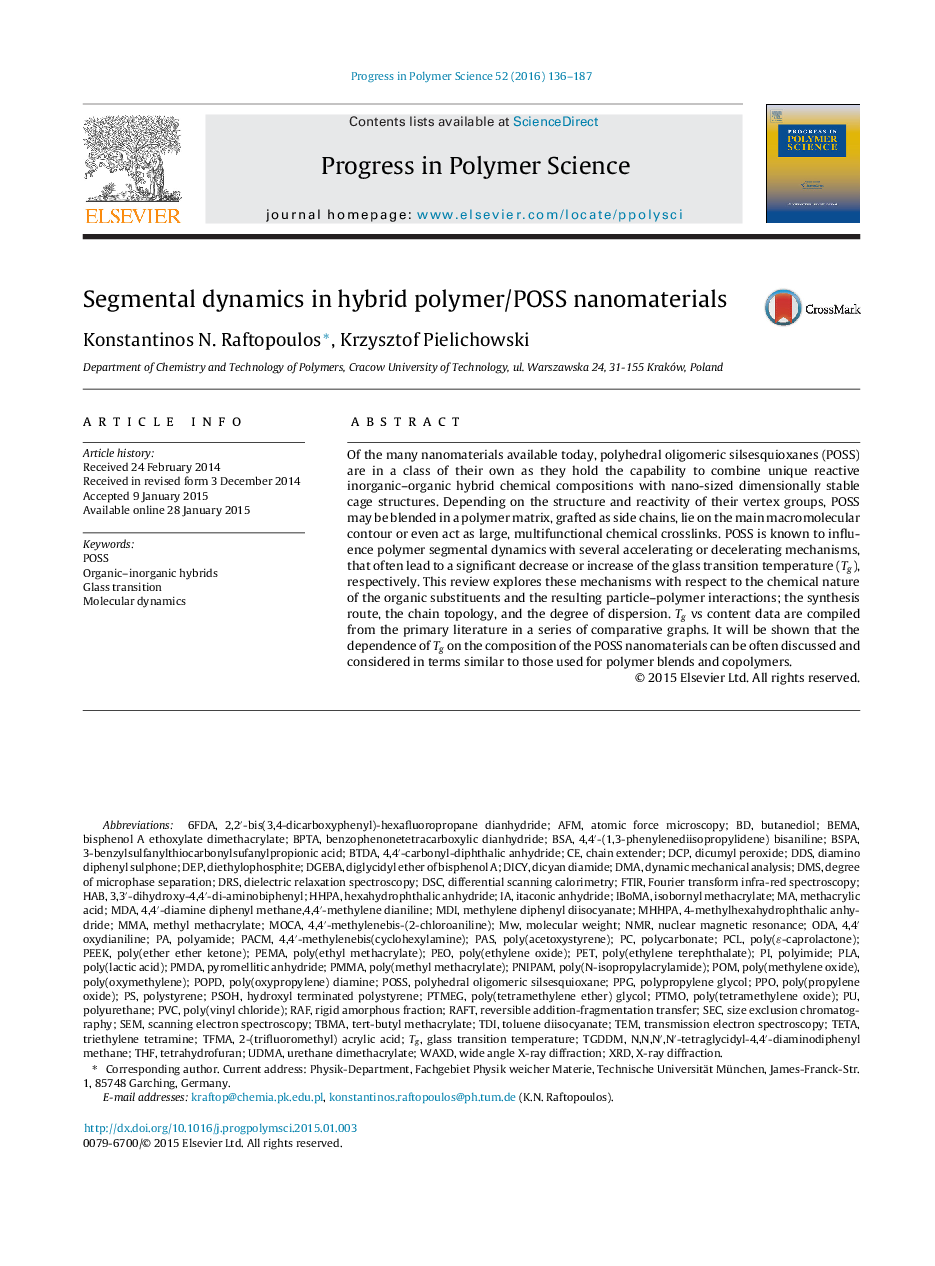| Article ID | Journal | Published Year | Pages | File Type |
|---|---|---|---|---|
| 5208005 | Progress in Polymer Science | 2016 | 52 Pages |
Abstract
Of the many nanomaterials available today, polyhedral oligomeric silsesquioxanes (POSS) are in a class of their own as they hold the capability to combine unique reactive inorganic-organic hybrid chemical compositions with nano-sized dimensionally stable cage structures. Depending on the structure and reactivity of their vertex groups, POSS may be blended in a polymer matrix, grafted as side chains, lie on the main macromolecular contour or even act as large, multifunctional chemical crosslinks. POSS is known to influence polymer segmental dynamics with several accelerating or decelerating mechanisms, that often lead to a significant decrease or increase of the glass transition temperature (Tg), respectively. This review explores these mechanisms with respect to the chemical nature of the organic substituents and the resulting particle-polymer interactions; the synthesis route, the chain topology, and the degree of dispersion. Tg vs content data are compiled from the primary literature in a series of comparative graphs. It will be shown that the dependence of Tg on the composition of the POSS nanomaterials can be often discussed and considered in terms similar to those used for polymer blends and copolymers.
Keywords
AFMDSCPCLDMASECHABTHFPOMDRSPLADEPPPORAFDMSMMATDIDDSDCPMoCAMDIPPGPMDAHHPAPOSSUDMAPNIPAMTGDDMWAXDDiglycidyl ether of bisphenol A6FDATriethylene tetraminePEMADGEBAMDAPTMEGPOPDtBMAtert-butyl methacrylatePtMoBTDABEMAMHHPAPACMnuclear magnetic resonanceBSAPolyhedral oligomeric silsesquioxaneItaconic anhydridehexahydrophthalic anhydrideODAMethacrylic acidGlass transitionTemButanediolFourier Transform Infra-Red SpectroscopyTetrahydrofuranDynamic mechanical analysisNMRChain extendertoluene diisocyanateTETAglass transition temperatureMolecular dynamicsDicumyl peroxideRAFTPEEKTransmission Electron SpectroscopyFTIRDielectric relaxation spectroscopyMethyl methacrylateMethylene diphenyl diisocyanateSEMatomic force microscopyPASOrganic–inorganic hybridsMolecular weightPETWide angle X-ray diffractionXRDX-ray diffractionPoly(N-isopropylacrylamide)Poly(ɛ-caprolactone)Poly(ether ether ketone)Poly(propylene oxide)Poly(tetramethylene oxide)Poly(lactic acid)Poly(methyl methacrylate)PMMAPolyamidePoly(ethyl methacrylate)poly(ethylene oxide)Poly(ethylene terephthalate)PolyimidePolypropylene glycolPolycarbonatePolystyrenePVCPolyurethanePEODifferential scanning calorimetrySize exclusion chromatographyRigid amorphous fractionPoly(vinyl chloride)urethane dimethacrylate
Related Topics
Physical Sciences and Engineering
Chemistry
Organic Chemistry
Authors
Konstantinos N. Raftopoulos, Krzysztof Pielichowski,
